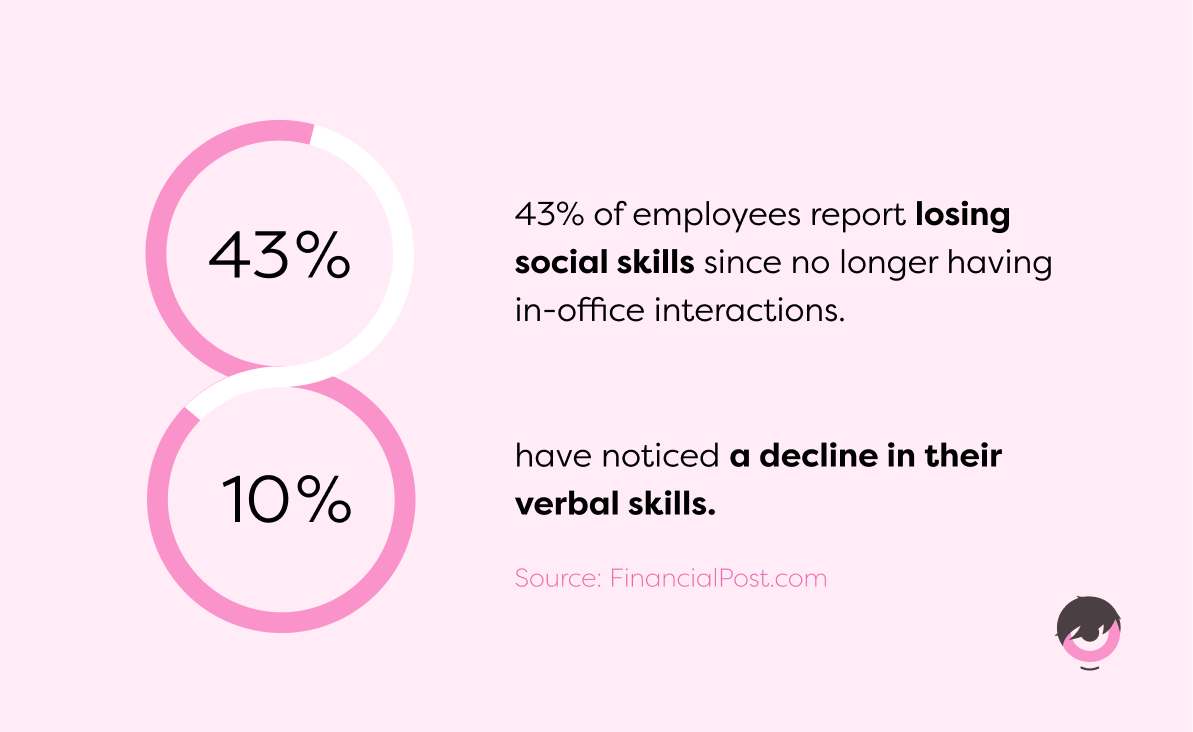You’ve likely heard a lot about this in recent months: numerous companies are now asking their employees to return to the office, either partially or fully. This shift comes after the pandemic-driven rise of remote work and growing expectations for flexibility in the workplace.
It’s often larger companies leading this charge, citing concerns about team cohesion and productivity losses when remote work becomes the norm. For them, in-office work fosters collaboration and innovation – two essential elements in an increasingly competitive job market.
But what exactly do these return-to-office policies entail? What impacts do they have? And what key stats should you know? Let’s break it all down so you can see the bigger picture and anticipate what’s next.
Key Stats and Facts About the Return to Office
For many workers, this return to the office has been a shock. It comes after years when workplace flexibility – be it hybrid models, flexible hours, or even four-day workweeks – became the standard.
Remote workers in the U.S. have been wary of this shift: in 2024, one in four remote workers feared being laid off before their in-office counterparts.
Here are some crucial facts and stats about the return-to-office trend globally:
- Major companies making headlines: UPS, Amazon, Google, Boeing, and X (formerly Twitter) have implemented drastic back-to-office mandates, often requiring employees to return five days a week. As usual, the U.S. leads this trend, which is showing no signs of slowing down.
- Canada’s stance: In Canada, 76% of companies have introduced plans for either partial or full returns to the office. Even organizations without official mandates are strongly encouraging employees to come in.
- European trends: In Europe, too, return-to-office mandates have been widely discussed. In France, organizations are questioning the efficiency of fully remote work and favoring hybrid or in-person systems.
- Legal battles: Some employees have successfully argued in court that forced returns to the office amount to constructive dismissal, keeping the topic at the forefront of workplace debates.

The Impact of RTO on Productivity and Employee Engagement
- Working parents and productivity: 61% of employees with children feel more productive working remotely.
- Job satisfaction: One in four workers say they would consider quitting if forced back to the office.
- Retention challenges: 75% of employees dissatisfied with workplace flexibility plans say they’re actively seeking new jobs.
These numbers highlight the significant risks of return-to-office mandates on employee morale and productivity. Most workers view this shift negatively, and organizations adopting these policies must excel at communication and provide compelling reasons to motivate their teams.
One solution gaining traction is the concept of “hybrid structured offices” designed to make in-person work more appealing by offering high-quality, innovative workspaces.
Why the Push for a Return to Office?
If employees are indeed happier and more productive working remotely, why are so many employers insisting on bringing them back to the office?
Measuring Productivity and Performance
While automating administrative tasks boosts employee productivity, it introduces challenges in assessing strategic, creative, or innovative contributions. Organizations without robust systems to evaluate remote performance are more likely to favor in-office work to better manage their teams.
Ironically, this mindset often leads to what’s known as a “Performance Doom Loop”, where micromanagement lowers productivity.
Office Space Expenses and Economic Impact of Remote Work
42% of workers believe employers mandate office returns to justify costly office space expenses. High rents and failed investments in office perks are sometimes pushing companies toward stricter in-person policies.
Furthermore, cities like Ottawa have noted that remote work among federal employees has harmed downtown economies, with office returns seen as a potential fix.
Career Development Challenges
Some organizations also argue that it’s difficult to implement mentoring, training, and career development programs remotely. While solutions exist to address this challenge, they aren’t always known or accessible to all organizations.
The numbers back up this argument: remote workers are 31% less likely to be promoted than their in-office colleagues. This statistic shows that physical distance can also create cognitive distance, as managers and employers are less likely to feel they know the profiles and performance of employees who don’t come to the office.
Productivity and Team Cohesion Issues
Of course, one of the main arguments behind the return to the office lies in the supposed decline in employee productivity in recent years. Studies have recently shown that remote work could negatively impact productivity. Although these claims have since been challenged, many organizations still view remote work as a barrier to innovation and collaboration.
In-office work is undoubtedly a powerful driver of team cohesion and the exchange of innovative ideas. Additionally, it can be challenging to maintain a strong, engaging company culture when all your talent is working remotely.
The Downsides of 100% Remote Work
We often talk – and rightly so – about the advantages of remote work for employee well-being and productivity. However, now that this work model is firmly embedded in our daily lives, we have enough hindsight to uncover its pitfalls and limitations:
- Quiet firing: As mentioned earlier, remote workers often face fewer career development opportunities, less recognition, ineffective performance tracking, increased risks of dismissal, and a lack of feedback. These challenges are part of the daily reality for many remote employees, who argue that such situations amount to quiet firing.
- Weakened company culture: It’s harder to feel a sense of belonging to a company when working 100% remotely. This results in feelings of disconnection from the company culture and drops in motivation and loyalty among remote workers.
- Loss of social and verbal skills: 86% of Canadians who have worked remotely say they experienced difficulties communicating or collaborating with colleagues in this setting. Additionally, 43% of employees report losing social skills, while 10% have noticed a decline in verbal skills since no longer having regular in-office interactions.

Solutions for a Balanced Return to Office
So, what are the solutions for companies that have identified the limitations of 100% or predominantly remote work and want to establish a return-to-office policy? And what about employees who signed contracts guaranteeing their right to remote work and whose work-life balance now relies on it?
Here are some tips and solutions for implementing a progressive and balanced return to the office while taking personal challenges and employee expectations into account:
1. Avoid Making Hasty Decisions
Is returning to the office truly beneficial for your productivity, employer brand, and company culture? Have you identified specific challenges related to remote work within your organization?
Ask yourself these questions before deciding on a return-to-office policy. Blindly following a trend won’t help if it does not benefit your business in the end.
Analyze your organizational reality and needs first to ensure you make the right choice. Define clear policies for everyone (partial or full return, RTO modalities, immediate or gradual implementation).
2. Adopt Balanced and Strategic RTO Policies
Returning to the office doesn’t necessarily mean going back to a 100% in-office system. You can encourage employees to come in one or two days per week before introducing a more defined organization-wide process.
Avoid sudden announcements that may cause panic, confusion, or loss of trust. It’s always wise to consult department heads to determine which policy would be best accepted and most beneficial for employees.
3. Adapt Measures to Your Organizational Reality
If your employment contracts specify that remote work is an intrinsic benefit, it will be difficult to justify a return-to-office mandate to your teams.
Similarly, if most of your employees live far from the office, issues of location and travel reimbursement will arise.
Finally, some workers are in personal situations (disabilities, for instance) that prevent them from coming to the office several days a week. These cases must sometimes be analyzed individually.
Your organizational reality and the needs of your talent will guide your decision-making and define what form your company’s return to the office will take.
4. Justify Decisions at Every Stage of the Process
Your decision should not be perceived as unjustified or unfair. Document your process to create a solid action plan to share with employees at every step. Your communication plan should highlight the reasons behind the decision (productivity stats, collaboration and communication challenges) and detail how the return to office will unfold.
We recommend that you implement a gradual RTO plan, such as a partial return spread over several months. Always be prepared to answer all your employees’ questions and fears.
5. Be Transparent and Empathetic
As with every organizational decision that changes employees’ daily lives and work habits, you need to communicate effectively and with total mutual respect with your teams. Answer their questions and concerns, and don’t hesitate to set up a committee dedicated to questions about returning to the office (this could be the HR department, or a committee focused on employee well-being).
Finally, don’t exert excessive pressure when implementing your return-to-work policy: in addition to losing the commitment and trust of your teams, you risk damaging your corporate culture and productivity.
In Conclusion: What Can We Expect in the Next Few Years?
Whether you’re an employee or employer, remote worker, or in-office worker, one thing is certain: the past few years have brought numerous and profound changes to the world of work. These changes have impacted us all and will continue to do so in the future.
While remote work hasn’t had its last word yet, it’s likely that technological advances and the growth of artificial intelligence will once again transform our practices and habits. Our advice for navigating this ever-changing working world: be adaptable and find a balance between productivity and well-being.

